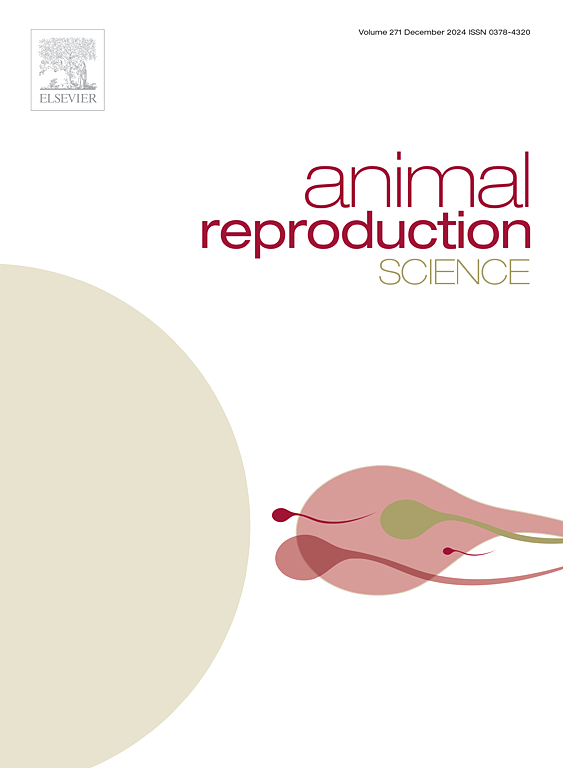An analysis addressing factors affecting risk of ovulation, pregnancy, and pregnancy loss in lactating dairy cows submitted to fixed-time artificial insemination programs with special reference to the diameter of the ovarian follicle
IF 3.3
2区 农林科学
Q1 AGRICULTURE, DAIRY & ANIMAL SCIENCE
引用次数: 0
Abstract
Because reduced fertility in studies resulted from GnRH-induced ovulation of small or large follicles in lactating dairy cattle, the objective was to determine the association of follicle diameter and risks of ovulation and pregnancy per artificial insemination (P/AI). An analysis was conducted of data from 14 studies in 82 herd-year-seasons in which ovulation was synchronized before a fixed-time AI. Follicle diameter was included as a continuous variable in a random-effects mixed model that used herd-year-season as a random surrogate for study. Effects of presynchronization, parity, cycling status, body condition score, occurrence of estrus, service sire, and progesterone were included as appropriate in initial models plus all two-way interactions. Ovulation risk after first GnRH treatment of Ovsynch increased (P < 0.001) with increasing follicle diameter. Ovulation risk after the breeding GnRH treatment increased (P = 0.03) in multiparous but not in primiparous cows as follicle diameter increased. Pregnancy per AI at d 28–37 and at d 56–84 was not associated with follicle diameter but was affected by presynchronization treatment (P = 0.03), ovulation after the breeding GnRH treatment (P = 0.003), parity (P < 0.001), prebreeding cycling status (P < 0.001), and progesterone (P < 0.001) before AI. As follicle diameter before AI increased, pregnancy loss by d 56–84 after AI decreased (P = 0.006), especially in cows of greater body condition. These results do not support any effect of follicle size on P/AI in cows whose ovulation is synchronized before AI, but less pregnancy loss was associated with increasing follicle diameter.
一项针对定期人工授精计划中影响排卵、妊娠和妊娠丢失风险的因素的分析,特别参考了卵巢卵泡直径
由于研究中gnrh诱导的泌乳奶牛小卵泡或大卵泡排卵导致生育力降低,因此目的是确定每次人工授精(P/AI)时卵泡直径与排卵和妊娠风险之间的关系。研究人员对82个畜年的14项研究数据进行了分析,这些研究在固定时间人工智能之前同步排卵。在随机效应混合模型中,毛囊直径作为一个连续变量,使用畜群年-季节作为研究的随机替代。预同步、胎次、循环状态、身体状况评分、发情发生、服役雄性和黄体酮的影响在初始模型和所有双向相互作用中酌情包括在内。第一次GnRH治疗后排卵风险随着卵泡直径的增加而增加(P <; 0.001)。经GnRH处理后,随着卵泡直径的增加,多产奶牛的排卵风险增加(P = 0.03),而初产奶牛的排卵风险没有增加。怀孕/人工智能在d d 28-37和56 - 84与卵泡直径无关,但受presynchronization治疗(P = 0.03),排卵后激性腺素释放素处理繁殖(P = 0.003),平价(P & lt; 0.001),prebreeding循环状态(P & lt; 0.001)和孕酮(P & lt; 0.001)人工智能。随着人工授精前卵泡直径的增大,人工授精后妊娠损失d 56 ~ 84降低(P = 0.006),尤其是体况较好的奶牛。这些结果不支持卵泡大小对人工授精前同步排卵奶牛的P/AI有任何影响,但卵泡直径增加与妊娠损失减少有关。
本文章由计算机程序翻译,如有差异,请以英文原文为准。
求助全文
约1分钟内获得全文
求助全文
来源期刊

Animal Reproduction Science
农林科学-奶制品与动物科学
CiteScore
4.50
自引率
9.10%
发文量
136
审稿时长
54 days
期刊介绍:
Animal Reproduction Science publishes results from studies relating to reproduction and fertility in animals. This includes both fundamental research and applied studies, including management practices that increase our understanding of the biology and manipulation of reproduction. Manuscripts should go into depth in the mechanisms involved in the research reported, rather than a give a mere description of findings. The focus is on animals that are useful to humans including food- and fibre-producing; companion/recreational; captive; and endangered species including zoo animals, but excluding laboratory animals unless the results of the study provide new information that impacts the basic understanding of the biology or manipulation of reproduction.
The journal''s scope includes the study of reproductive physiology and endocrinology, reproductive cycles, natural and artificial control of reproduction, preservation and use of gametes and embryos, pregnancy and parturition, infertility and sterility, diagnostic and therapeutic techniques.
The Editorial Board of Animal Reproduction Science has decided not to publish papers in which there is an exclusive examination of the in vitro development of oocytes and embryos; however, there will be consideration of papers that include in vitro studies where the source of the oocytes and/or development of the embryos beyond the blastocyst stage is part of the experimental design.
 求助内容:
求助内容: 应助结果提醒方式:
应助结果提醒方式:


